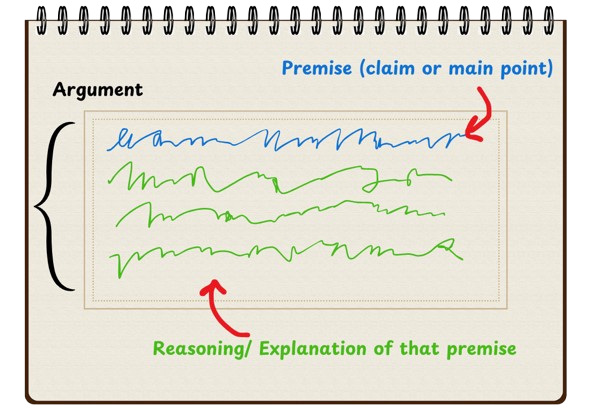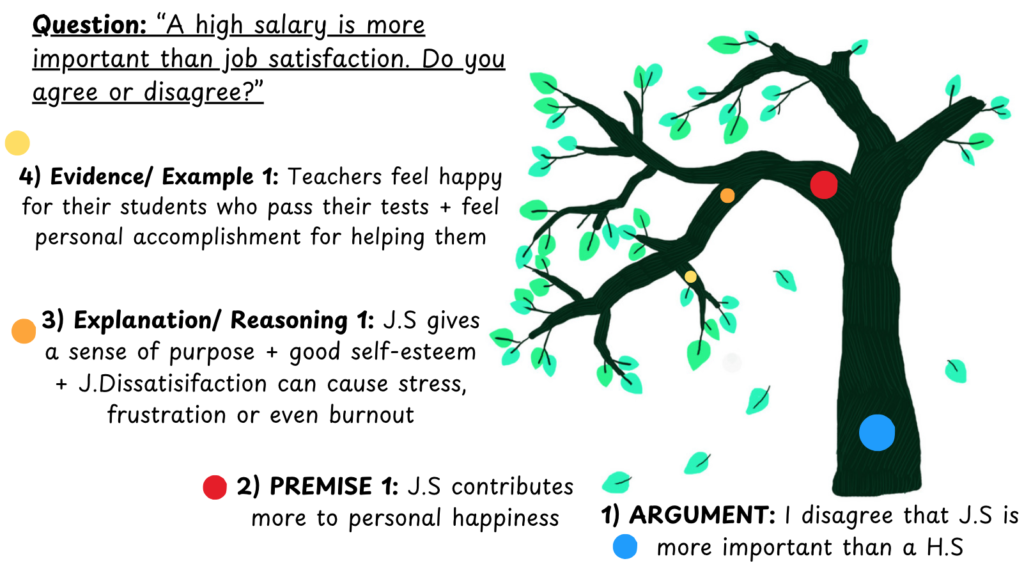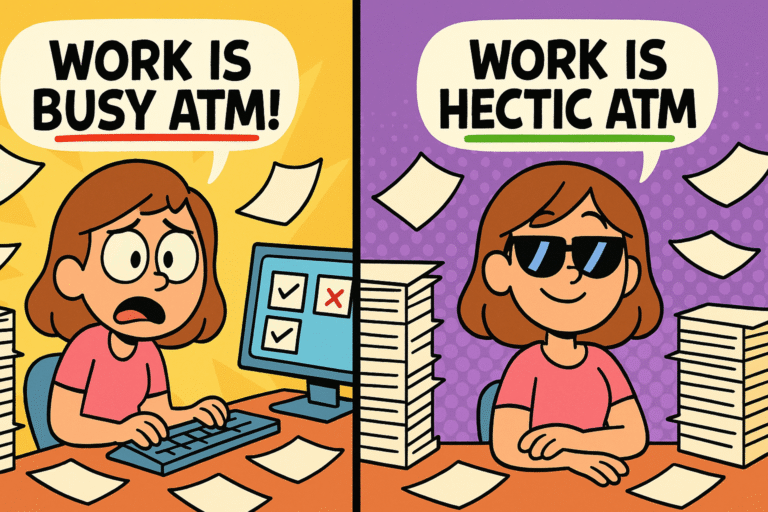
Components of a Main Body Paragraph
Each main body paragraph should make an argument. (This doesn’t mean that you have to argue.
Arguments are made up of premises, which are supported by explanations/ reasoning, aimed at convincing the reader of a particular viewpoint or conclusion.
Illustrating the Argument, Premise, Explanation/ Reasoning & Examples/ Evidence
Using the idea of a tree, you can visualise how each of these parts connect together.
- The trunk is your argument, and it is what your whole paragraph is about, and after reading it, you hope the examiner will accept your conclusion as true, acceptable or reasonable.
- The main branches are your premises ( your claims or main points), which must be strong.
- The smaller branches are your explanations or reasoning, where you communicate the logic behind your premise.
- Finally, the twigs, or perhaps you can imagine leaves, are the evidence or examples that you can use to illustrate and strengthen your explanation/ reasoning.

Different Structures of Main Body Paragraphs- Should we always write the premise first?
1) Deductive Structure
- Premise-> Explanation/ reasoning -> Example/ Evidence
- Most direct and reader-friendly approach
If we put our argument about job satisfaction into a main body paragraph with a deductive structure, it looks something like this:
“The first reason why job satisfaction is more important than having a higher salary is that it contributes more to personal happiness. While career contentment provides a sense of purpose and can build self-esteem, having only a high salary without enjoying your job can have a negative effect on a person’s life, often causing stress, frustration and even burnout. Teachers, for instance, not only feel happy for their students when they pass their tests but also get a sense of accomplishment for helping them. “
It is the best structure for most students because it reduces the chance of the students forgetting to provide a premise, which is crucial, and it is also an intuitive structure to use. It also makes it very clear for an examiner to read and follow. However, as students become more skilled and confident, they can learn the other structures, which can help to vary their sentence structure.
But is also possible to rearrange the sentences if we need.
2) Premise in the middle
- Explanation/ reasoning-> Premise -> Example/ Evidence
- Begins with context, background, or an example before introducing the main premise
- Engages the reader/ Sets up a more persuasive argument
This is where you put the premise in the middle.
“While career contentment provides a sense of purpose and can build self-esteem, having only a high salary without enjoying your job can have a negative effect on a person’s life, often causing stress, frustration and even burnout. Therefore, job satisfaction is more important than having a higher salary as it contributes more to personal happiness. Teachers, for instance, not only feel happy for their students when they pass their tests but also get a sense of accomplishment for helping them.“
3) Inductive Structure
- Example/ Evidence -> Explanation/ reasoning-> Premise
- Begins with evidence, examples or reasoning first
- Finishes with the premise as the logical conclusion
Finally, the where the premise can be added at the end, this is called an inductive structure.
“Teaching is a profession which does not typically have a high salary but it well known that educators derive happiness from their students, especially feeling proud when they pass their tests as they get a sense of accomplishment for helping them. While career contentment provides a sense of purpose and can build self-esteem, having only a high salary without enjoying your job can have a negative effect on a person’s life, often causing stress, frustration and even burnout. Therefore, job satisfaction is more important than having a higher salary as it contributes more to personal happiness.“
Providing Examples/ Evidence
1) Examples/ evidence don’t always have to be Split into separate sentences
Look at the following example:
Question: Some people think that cities are the best places to live. Others prefer to live in rural areas. Discuss both views and give your own opinion.
Answer: Cities are better to live in because of the amenities available. Cities offer a wide range of facilities, such as hospitals, schools, entertainment options, and shopping centres, which may not be as readily available in rural areas.
Let’s break it down:
- Premise: Cities are better to live in because of the amenities available.
- Explanation/ Reasoning: Cities offer a wide range of facilities, which may not be as readily available in rural areas.
- Example/ Evidence: such as hospitals, schools, entertainment options, and shopping centres.
This organisation is especially useful when you have a number of premises which you want to mention in your main body paragraph.
2) Not all premises require an example/ evidence

Sometimes the premise and/ or explanation are sufficient, and providing an example is unnecessary. They are self-evident. Consider the following:
Question: Some people say it is more important to plant trees in the open spaces in towns and cities than to build more housing. To what extant do you agree or disagree?
Answer: Planting trees in urban areas are more important because they improve the air quality. They absorb carbon dioxide and release oxygen, which directly benefits the atmosphere.
- Premise: Trees should be planted because they improve the air quality.
- Explanation/ Reasoning: They absorb carbon dioxide and release oxygen, which directly benefits the atmosphere.
After providing the explanation/ reasoning, we can’t exactly give an example of this. It is inherently obvious or apparent, requiring no further proof or demonstration because its truth is immediately recognisable.
Exercise 4: Quiz- Argument, Premise, Explanation/ Reasoning & Examples/ Evidence
Other Methods of Reasoning

1) Cause and Effect Reasoning
In this type of reasoning, you prove the validity of your premise by showing the knock-on effect it has. Essentially the domino effect.
Question: Around the world, rural people are moving to cities and urban areas. What problems does this cause?
Answer: One issue which could be caused by urbanisation is overpopulation, which can lead to its own set of challenges. For instance, this will mean the demand for housing will outpace the supply, which will push prices up and create a shortage of affordable housing.
In this answer, the premise is strengthened each time an effect is explained and shown to create another issue.
Here you can see 1 premise and 3 problems. Presenting these 3 problems are all used to support the premise (that urbanisation causes overpopulation, which leads to more problems).
- Premise: One issue which could be caused by urbanisation is overpopulation, which could lead to its own set of challenges.
- Problem 1: The demand for housing will outpace the supply
- Problem 2: which will push prices up
- Problem 3: and create a shortage of affordable housing.
As a result of a premise that then digs deeper and explains the knock-on effects, the reader can come to a conclusion.
This is not the same as having many ideas that have not been expanded upon, which is not advised. That would look something like this:
One issue which could be caused by urbanisation is overpopulation. Also, the demand for housing will outpace the supply. The prices will go up as well. Additionally, there will be a shortage of affordable housing.
This answer hasn’t been presented to show a knock-on effect, but instead just adds new ideas without connection.
Common Linking:
For a causal argument, we often use linking like: this means that, this causes, this results in, as a result, in turn, as a consequence, this leads to etc.
2) Hypothetical Reasoning/ Extrapolation
In this type of reasoning, you imagine the potential outcomes or effects of a specific action or to justify a premise.
These are essentially conditional sentences. Let’s look at an example:
E.g. If you eat McDonald’s every meal, every day, you will probably get fat.
When we present this type of reasoning, we should consider and state its degree of probability. Is it highly likely, probable, possible, unlikely etc?
To show this, we can use modal verbs and other words too. E.g. Would, might, may, could, likely to.. etc.


3) Contrastive Reasoning
This is a method where the writer shows the merit of their argument by investigating the contrasting or opposite argument. The objective is to show that your argument is more valid, reasonable or acceptable than the one you explore.
Let’s look at an example. First, look at the classic direct reasoning, then notice how we change it into contrast reasoning.
Direct reasoning
We should invest more in renewable energy to reduce carbon emissions and combat climate change. Renewable energy sources like wind and solar are sustainable, clean, and critical to our future.
Contrast reasoning
Imagine if we do not invest in renewable energy. Our reliance on fossil fuels will continue to drive carbon emissions up to dangerous levels, resulting in worsening climate change, more extreme weather events, rising sea levels, and devastating impacts on ecosystems and human communities. The cost of inaction will far outweigh the investment needed now.
You see, both are correct. Understanding both ways of arguing help us to be more flexible in the exam and also to strengthen our argument.
Note some vocabulary often used for contrast reasoning: if, but, in contrast, by contrast, however, nonetheless, nevertheless, while, whereas, although, despite, in spite of, on the contrary, on the other hand, conversely, instead, alternatively, in contrast to, as opposed to, unlike, different from, in comparison to, compared with, if we look at the opposite scenario.
Exercise 5: Quiz- Cause and Effect, Hypothetical/ Extrapolation & Contrastive Reasoning
How Many Premises Should You Have Per Paragraph?
There is no fixed limit to the number of premises you can have per paragraph, but the ideal number depends on clarity, coherence, and the complexity of the argument. Having said that though, typically 1 or 2 is best and 3 can be ok but anything more than that and you simply aren’t able to cover these premises well.
Observe the following main body paragraphs which include 1, 2 and 3 premises. In this example, each shows 1 main body paragraph of around 140 words. This is an amount that a very skilled writer can reach, but students who are aiming for band 6 and 7 can get their score having 90-100 words per main body paragraph.
Therefore, understand that with:
- 1 premise, you would have roughly 90 words per body paragraph.
- 2 premises, you would have roughly 45 words each per body paragraph.
- 3 premises, you would have roughly 30 words each per body paragraph.









